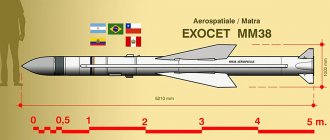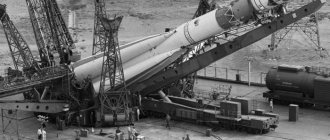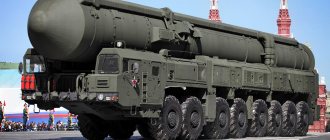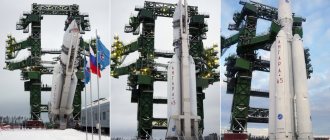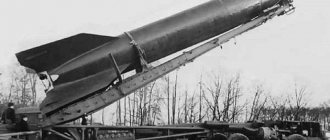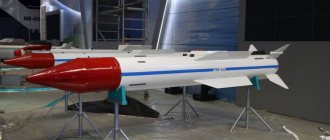Let's get started
The task of reducing the cost of launching a payload is currently urgent throughout the world. Already now, the organization of private space enterprises is rapidly gaining popularity abroad, thanks to which there are positive trends in reducing the cost of launches on the international market for placing spacecraft (SC) into orbit. If we consider a spacecraft from the point of view of launch vehicles, that is, as a payload of a launch vehicle (LV), then the spacecraft will be classified according to its mass and size characteristics and the altitude of the reference orbit to which it must be launched. The currently observed trend towards reducing the weight and dimensions of spacecraft, along with an increase in the number of small spacecraft (SSV) [1], is explained not only by the low cost of manufacturing and launch, but also by the relatively short development time, as well as the ability to solve various problems in the interests of business and science [2]. The general concept of small spacecraft is quite broad: it includes all artificial satellites weighing over 0.5 kg. up to 1 ton. The most promising and currently actively developing direction is the CubeSat-type small satellite format. The currently launched and projected number of CubeSats is shown in Figure 1
Figure 1. MCA development trends [3]
It is also necessary to take into account plans for the deployment of multi-satellite constellations, primarily low-orbit space broadband communication systems, which in the next 10 years could number more than 16,000 small mini-class spacecraft weighing up to 300–400 kg. To support constellations, light launch vehicles [4] will be needed, designed to launch a payload weighing from a few kilograms to 500 kilograms into low Earth orbit. Such carriers will be subject to minimum cost and high launch efficiency requirements. A distinctive feature of small satellite constellations is the low lifetime of individual satellites in LEO due to accelerated orbital decay compared to heavier satellites and the gradual degradation of the industrial and consumer electronics used in their creation. Since all design and construction parameters of the launch vehicle are interconnected, minimizing the cost of launching the launch vehicle from a technical and economic point of view can be achieved through the use of more modern technologies for the manufacture of launch vehicle elements (the use of additive technologies), the use of consumer and industrial components and assemblies available on the market (especially this relevant in the development of control systems) by increasing energy and mass perfection, partial replacement of full-scale tests with virtual ones in the manufacture of structures, as well as reuse of launch vehicle units.
Based on an analysis of the satellite market, the following requirements for a promising launch vehicle have been formed:
- payload weight: 250 kg;
- target orbit: 500 km.
In addition, taking into account the experience of leading foreign private space companies (Space X, Blue Origin, etc.), as well as based on the interests of the long-term development of the space industry, which require a radical reduction in the cost of launching a payload, it was decided to consider the option of a partially reusable launch vehicle. Options for a fully reusable system, such as air launch + aerospace aircraft and a single-stage launch vehicle, were discarded due to high technical risk. Options for a system with a returnable first stage were considered more promising.
Let's consider the options for launch vehicle layouts, see Figure 2.
- Tandem design (in which the stages are located one after the other and operate alternately in flight)
- Package scheme (several blocks located in parallel and belonging to different stages operate simultaneously in flight)
Figure 2. LV layout options
There are few options for implementing “reusability” for these layouts; as a rule, a tandem scheme with a reusable first stage (like Falcon 9), or a package scheme with reusable side blocks (like the hypothetical Energy - 2) is considered. However , it seemed to us that when solving such a non-trivial problem, it is worth looking at the issue more broadly, not limiting ourselves only to the classic options for disposable launch vehicles. In both the batch and tandem configurations, the second stage during insertion is loaded with aerodynamic forces and heating, although its working section lies in the rarefied upper layers of the atmosphere. You can gain in mass characteristics by abandoning the heat-shielding coating and reducing the thickness of the skin of the tanks and adapter, if you place the second stage in the first stage compartment, protecting the structure of the second stage from the thermal and force effects of the atmosphere. Having analyzed, to a first approximation, the ballistic and mass characteristics of the launch vehicle for the trajectories of launching a payload weighing 250 kg into a reference orbit of 500 km, we came to the conclusion that the optimal mass of the second stage for a two-stage rocket with such characteristics is less than 5 tons, and its maximum linear dimensions taking into account the payload, they do not exceed 6.5 meters in length and 1.7 meters in width, which gives some freedom in choosing the layout. It was decided to abandon the use of a jettisonable fairing and place the second stage entirely inside a special compartment of the first stage. It was decided to make the first stage conical in shape, since such a shape is known to provide acceptable aerodynamic characteristics in a wide range of Mach numbers. To improve aerodynamic quality and controllability, see Figure 3, the launch vehicle has an all-moving tail located in the nose, as well as additional aerodynamic surfaces located in the tail.
Let us next consider the main parameters and some results.
Falcon Heavy - launch vehicle capabilities
The American space rocket Falcon Heavy (Falcon Heavy, “Heavy Falcon”) from SpaceX ( the brainchild of Elon Musk) is currently the most powerful and lifting rocket in the world. With a launch mass of almost one and a half thousand tons (1,420,788 kg), Falcon Heavy is theoretically capable of launching a cargo weighing 64 tons into low Earth orbit - i.e. the weight of a Boeing 737 type passenger airliner including passengers, luggage and fuel. For comparison, the Russian Proton M launch vehicle lifts a payload of 23 tons to the same height, and the American Delta-IV launch vehicle, as part of the Space Shuttle program, lifted 24 tons of payload.
American private space company SpaceX proposes reusing space rocket stages
Thus, if we take purely theoretical calculation data, Falcon Heavy is a truly powerful step forward - compared to its closest “competitor,” this launch vehicle is capable of introducing 2.5 times more cargo, while its launch, according to the manufacturer, costs only a third from the cost of launching the same “Delta-IV”.
The basis of the design of the “heavy “Falcon”” is a bunch of three “Falcon 9” rockets (i.e. “Falcon-9”), which serve as the launch vehicle as the first stage. Each of the three Falcons is equipped with 9 Marilyn 1D engines, for a total of 27 engines with a total thrust of 5,000,000 pounds. Again, when compared with passenger Boeings, this approximately corresponds to the power generated by 18 Boeing 747 type aircraft at takeoff. Impressive, right?
The main task for which the Falcon Heavy was created was long-term flights, not to low-Earth orbit, but to much more interesting targets, such as the Moon or Mars. Although the carrying capacity of the “Heavy Falcon” will be much less, nevertheless, it still remains very impressive. Judge for yourself, the carrying capacity of the Falcon Heavy launch vehicle:
- For low Earth orbits is: 64 tons
- For geotransfer orbit: 26.7 tons
- For flight to Mars: 16.8 tons
- For flight to Pluto: 3.5 tons
...and even 3.5 tons are very strong numbers, considering the flight time and distance to the target.
However, it is worth noting that Mars or Pluto are unlikely to see their “Falcon” in the coming years - despite the advertising ending about the conquest of distant planets, SpaceX has not announced any long-distance flights in the near future, but promises to “fill up” the Earth’s orbit with satellites in Lately it has been heard more and more often. This is understandable; after all, SpaceX is not a research project, but a commercial one.
Falcon Heavy rocket takes off from Canaveral Space Center
History of creation
The history of creation began long before the first launch. It began with a resolution of the CPSU Central Committee on the need to develop a new intercontinental ballistic missile that could deliver a thermonuclear charge over a considerable distance, estimated in thousands of kilometers. After several years of development, the task was completed. The intercontinental two-stage missile of a new type of ICBM R-7A entered service with a specially created unit of the missile forces. The first launch took place in 1959. In various modifications, the R-7 remained in service for only 10 years, but thanks to its high modernization potential and successful design, it became the basis for a whole family of space launch vehicles.
Already after the first manned flight into space, as part of the implementation of a program of longer flights, the development of a new rocket based on the R-7 began. The problem was that all the rockets of the Soviet Union at that time, including Voskhod, were not suitable for operation within the framework specified by the project. In addition to increasing the flight duration, the new rocket was supposed to have an emergency crew rescue system in case of an emergency, which was not provided for on Voskhod.
The basis for the design of the new middle-class rocket of the R-7 family was the already operational Voskhod and R-7A launch vehicles. The new launch vehicle received the name “Soyuz” and the index 11A511. This three-stage launch vehicle was used to launch the Soyuz and Progress spacecraft. The first launch of a Soyuz rocket took place in 1966.
Falcon Heavy launch vehicle and myths
To be completely precise, one cannot help but note the fact that the Falcon Heavy’s payload capacity figures stated above look so impressive only at first glance.
The relatively low cost of launching the Falcon Heavy launch vehicle is ensured by the fact that part of its elements (and this is the entire first stage - that is, all three “hulls” from Falcon 9 along with the engines) are made recoverable and suitable for repeated launches. However, the Sokolov bunch provides a record “useful” weight of 64 tons only with the expectation that... all three upper stages will not return and will burn up in the atmosphere, like the same “Delta-4” or “Proton-M”.
If we count on a “regular” launch with return stages, then the payload is reduced by half - to 30 tons in low orbit. At the same time, it is worth noting that in the history of astronautics there were launch vehicles that “reached” the bar not even at 64, but at 100 tons - the American Saturn-5 (theoretically up to 140 tons) and the Soviet Energia (confirmed 105 tons). So if you take the matter seriously, it becomes clear that not only the designers, but also the marketers did a good job on the Falcon Heavy.
Spectacular footage of the landing of two return boosters (each of them is actually a Falcon 9 rocket) from the Falcon Heavy super-heavy rocket
Links[edit]
- NASA Space Technology Roadmaps - Launch Propulsion Systems, page 11: "Small: 0-2t payloads, Medium: 2-20t, Heavy: 20-50t, Super-heavy: >50t."
- ↑
May, Sandra (27 August 2014). "What is a heavy launch vehicle?" . NASA. Retrieved June 11 +2017. - "Ariane 5 User's Manual, Issue 4, Page 39 (ISS Orbit)" (PDF). Arianespace. Archived from the original (PDF) on September 27, 2007. Retrieved November 13, 2007.
- "Lanzamiento del ATV-5 Georges Lemaitre (Ariane 5 ES)".
- “Arianespace celebrates its milestone in mid-2022 with the launch of the record-breaking Ariane 5 mission on ViaSat and Eutelsat services” (press release). Arianespace. June 1, 2022. Retrieved June 2, 2017.
- "Arianespace launches two spacecraft on mission to explore the universe". Arianespace
. Retrieved January 6, 2022. - ^ ab "Delta IV Launch Services User Guide, June 2013" (PDF). United Launch Alliance. June 2013. pp. 2–10. Archived from the original (PDF) on July 10, 2014. Retrieved October 9, 2022.
- "NASA NASA Orion Exploration Flight Test-1 PRESS KIT" (PDF). NASA. December 2014. p. 12.
- "Long March 5B launch clears path for China's space station project". SpaceNews.com
. May 5, 2022. Retrieved June 5, 2022. - ↑
Barbosa, Rui S. (4 May 2022).
"First launch of new generation space capsule at Long March 5B loft". nasaspaceflight.com
. Retrieved May 5, 2022. - "China's first Long March 5B rocket launches crew capsule test flight". Spaceflightnow.com
. May 5, 2022. Retrieved May 5, 2022. - "SJ 20 - Gunther's Space Page". space.skyrocket.de
. Retrieved January 6, 2022. - "Proton Launch System Mission Planner's Guide - Section 2: LV Characteristics" (PDF). International launches. July 2009. Retrieved June 11 +2017.
- Krebs, Gunther. "ViaSat 1". Gunther's Space Page
. Retrieved June 11 +2017. - "ExoMars Trace Gas Orbiter (TGO)". European Space Agency. July 12, 2012. Retrieved March 8, 2014.
- "Space flight 101, Angara-A5". Archived from the original on August 9, 2022. Retrieved December 22, 2015.
- “The cargo was delivered into orbit: the Angara launch was carried out as usual.” . Vesti.ru
. December 14, 2022. - Features and Services (2016)
- de Selding, Peter B. (15 June 2016). "Iridium's SpaceX launch slowed by Vandenberg bottleneck". SpaceNews
. Retrieved June 11 +2017. Each Iridium Next satellite will weigh 860 kg at launch for a total satellite payload mass of 8600 kg, plus a 1000 kg dispenser. - "SpaceX and Cape Canaveral Return to Action with First Operational Starlink Mission". NASASpaceFlight.com
. November 1, 2022. Retrieved November 11, 2022. - ↑
Graham, William (3 July 2022).
"SpaceX Falcon 9 launches from Intelsat 35e on third try". NASASpaceflight
. - Krebs, Gunther. "Telstar 19V (Telstar 19 Vantage)". Gunther's Space Page
. Gunther. Retrieved August 7, 2022. - "DSCOVR: Deep Space Climate Observatory" (PDF). NOAA. January 2015. Archived from the original (PDF) on April 2, 2015. Retrieved March 14, 2015.
- https://www.spacex.com/about/capabilities
- Arabsat 6A. Gunther's Space Page
. Retrieved April 13, 2022. - "Tesla Roadster (AKA: Starman, 2018-017A)". ssd.jpl.nasa.gov
. March 1, 2022. Retrieved March 15, 2022. - Entering the race to the Moon, Saturn IB took its place in space.
- “GKNPTs named after M.V. Khrunichev | Service module "Zvezda"". www.khrunichev.ru
. Retrieved January 6, 2022. - "Proton Data Sheet". www.spacelaunchreport.com
. Retrieved January 6, 2022. - "Encyclopedia of Astronautics Index: 1". www.astronautix.com
. Retrieved January 6, 2022. - ↑
Astronautix.com, Titan IV. Archived February 18, 2016, at the Wayback Machine. - "Bezos' Blue Origin will deliver first flight-ready rocket engines next summer - ULA CEO". Reuters
. - "United Launch Alliance Building Rocket of the Future with Industry-Leading Strategic Partnerships" (press release). United Launch Alliance. September 27, 2022. Retrieved September 28, 2018.
- "ESA seeks another €230m for Ariane 6 as maiden flight moves to 2022". SpaceNews
. - Rhianna
Clarke, Stephen (13 August 2016).
"Rocket holding Ariane 6 scheduled for first flight in 2022". Spaceflight now
. Retrieved August 13 +2016. - Lagier, Roland (March 2018). "Ariane 6 User's Manual Issue 1 Revision 0" (PDF). Arianespace. Retrieved May 27, 2018.
- "Blue Origin delays first launch of New Glenn until late 2022". SpaceNews
. - Faust, Jeff (8 March 2017). "Blue Origin's First Eutelsat New Glenn Customer". SpaceNews
. Retrieved March 8, 2022. - "ULV" www.b14643.de
. Retrieved January 6, 2022. - DeRoy, Rich S.; Reed, John G. (February 2016). "Vulcan, ACES and Beyond: Delivering Tomorrow's Space Launch Services" (PDF). Successes in astronautics
.
Univelt. 157
: 228. AAS 16-052. Retrieved September 28, 2022. - "Volcano Centaur". United Launch Alliance. 2022. Retrieved September 28, 2022.
- "Mitsubishi Heavy Industries mulls upgraded versions of H3 rocket for lunar missions". SpaceNews
. October 25, 2022. Retrieved January 6, 2022. - "The constellation is dead, but the parts live". Aviation Week
, October 26, 2010
How the Falcon Heavy rocket works
Technically, the Falcon Heavy launch vehicle is a two-stage rocket, externally reminiscent of the same American Delta-4.
The first stage of Falcon Heavy consists of a bunch of three “Falcon 9” rockets, accelerating the entire structure during the first stage of flight, and then, as fuel is consumed, separating from the body of the main rocket (at first two side ones, a little later the central one), and (in the “economical” stage) mode implying further use), not burning up in dense layers of the atmosphere, but landing safely on launch pads with the help of special maneuvering engines. The first stage engines actually have only one operating mode - “full forward!”.
The second stage is equipped with the same engines (“Merlin”) as the first stage, but this engine differs in that it can be shut down and restarted several times, allowing the rocket to maneuver and change its orbital altitude.
Upon reaching a given orbit, Falcon Heavy drops its nose fairing, which consists of two halves and protects the payload from damage. In addition to the option with a head fairing, there is also the option of installing the Dragon spacecraft developed by SpaceX in its place.
Comparison of the appearance and characteristics of the Falcon 9 and Falcon Heavy rockets
Stages of the Soyuz launch vehicle
The two stages of the launch vehicle are similar to the Vostok launch vehicle, but with a number of improvements. The first stage of the rocket consists of 4 side cone-shaped accelerator blocks. Each accelerator has autonomous engines. The separation of the accelerator blocks during launch occurs approximately 118 seconds into the rocket's flight. The mass of the side block without fuel is no more than 3.75 tons, the weight of the fuel is 155-160 tons.
The second stage includes fuel and payload. Weight without fuel is no more than 6 tons, fuel is 90-95 tons. The second stage separates from the launch vehicle at approximately 278 seconds of flight.
The third, modified stage is the modernized block “I” of the Voskhod 11A57 launch vehicle with a total length of 6.7 m and a diameter of 2.66 m. Equipped with a 4-chamber liquid fuel rocket engine with one turbopump unit. Total weight 25 tons.
Soyuz rocket - fuel and propulsion systems
The fuel used for propulsion systems of all stages was identical - T-1 kerosene. Liquid oxygen was used as an oxidizing agent. This is a highly explosive substance, but not toxic. Liquid nitrogen and hydrogen peroxide were used in small quantities to operate the auxiliary systems.
For the first stage, four 4-chamber liquid rocket engines (liquid rocket engines) RD-107 8D728 were used as a propulsion system. Each Soyuz rocket engine of the first stage had 4 main fixed combustion chambers and 2 rotary-steering ones on hinged suspensions. The total weight of the engine was 1300 kg.
The control system of the second stage of the Soyuz rocket is an RD-108 liquid-propellant rocket engine, consisting of 4 fixed and 4 rotating chambers with a deflection of 350, which were the executive controls of the rocket and were used to control the position of the rocket in space. This is an open cycle engine with supercharging and gas generation systems weighing 1195 kg.
For the third stage - a highly reliable liquid propellant rocket engine RD-0110 11D55. This is an open-cycle engine with turbocharged fuel supply, created at OKB-154 under the command of S. A. Kosberg and also had 4 main and 4 rotary combustion chambers. The maximum time for continuous operation is 250 seconds.
Launches
The Soyuz launch vehicle began successfully launching artificial Earth satellites into space in 1966. Initially, these were devices of the Cosmos series, and later manned spacecraft. During the first 10 years of operation of the 11A511 launch vehicle, 32 launches were carried out from the Baikonur Cosmodrome, 30 were successful.
Subsequently, several modifications were created on the basis of the Soyuz launch vehicle to perform various tasks, mainly for launching domestic and foreign spacecraft for various purposes. For launches of the Soyuz launch vehicle, 7 launch sites were created:
- Baikonur – 2 sites.
- Plesetsk – 3.
- Guiana Space Center (French Guiana) – 1.
- Vostochny Cosmodrome - 1.
The total number of launches of all Soyuz rockets is 1020. At the end of 2016, a total of 44 launches of Soyuz 2.1a and Soyuz 2.1b launch vehicles were made.
Emergency rescue system
When developing the Soyuz launch vehicle, one of the key tasks facing the designers was to create a system for rescuing the crew in the event of an emergency. As a result, an emergency rescue system (ESS) was developed and implemented, which was activated before the rocket launched and, if necessary, provided rescue for the crew at the launch or during any part of the flight.
The system provides for the removal of the head unit with the crew from the rocket to a safe place along with the fairing, descent and instrumentation apparatus. To do this, rocket separation engines were installed on the head fairing, running on solid fuel in combination with four small control engines. At the very top of the head fairing there was a small engine, the task of which was to move the entire module to the side after the separation propulsion system was activated. This system has become standard for all Soyuzs.
